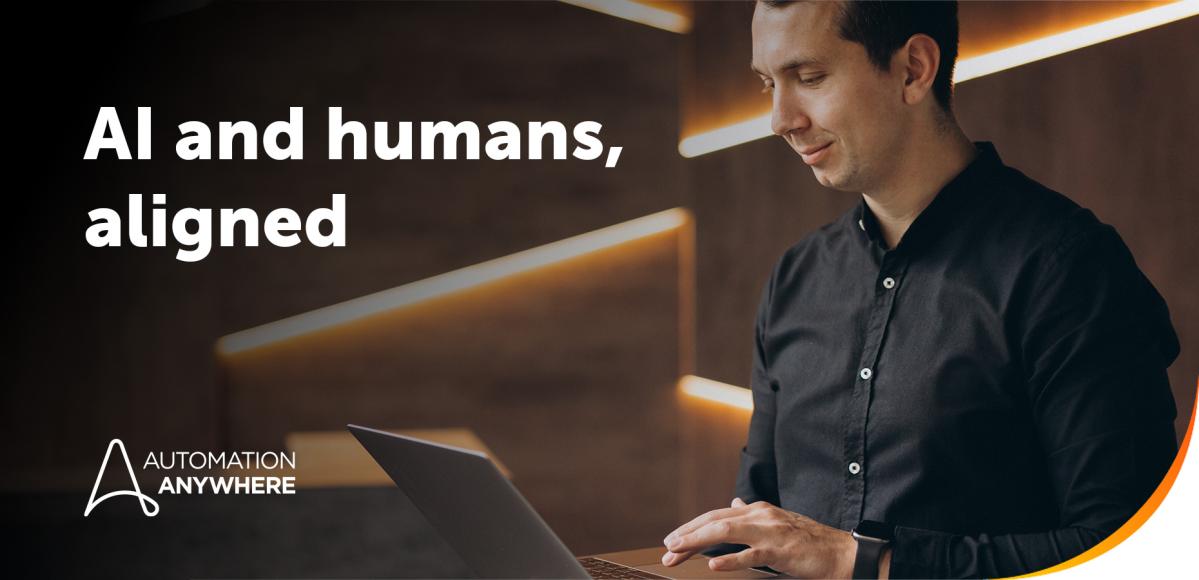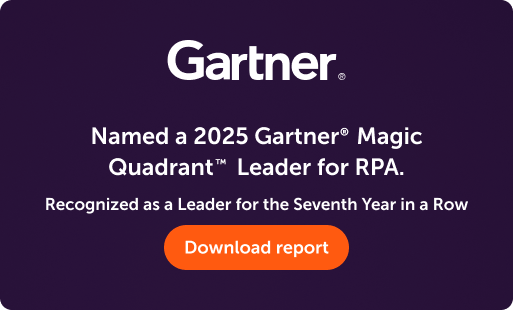- Login
- Search
- Contact Us
-
Have a question? Our team is here to help guide you on your automation journey.
-
Explore support plans designed to match your business requirements.
-
How can we help you?
-
- .AI
AI Without the Hype From pilot to full deployment, our experts partner with you to ensure real, repeatable results. Get Started
- Automation Anywhere AI
-
- Solutions
Featured Agentic Solutions
Accounts Payable Invoice automation—No setup. No code. Just results. Accounts Payable
Customer Onboarding Scale KYC/AML workflows. Customer Onboarding
Customer Support Keep queues moving, even at peak load. Customer Support
Healthcare RCM Revenue cycle management that runs itself. Healthcare RCM
- Products
Platform Features
- Agentic process automation (APA)
- Robotic Process Automation (RPA)
- View all Products
-
- Resources
Get Community Edition: Start automating instantly with FREE access to full-featured automation with Cloud Community Edition.
Featured
 Named a 2025 Gartner® Magic Quadrant™ Leader for RPA.Recognized as a Leader for the Seventh Year in a Row Download report Download report
Named a 2025 Gartner® Magic Quadrant™ Leader for RPA.Recognized as a Leader for the Seventh Year in a Row Download report Download report- Become an Expert
- Developer Tools
- Get Support
- View all resources
-
- Partners
Find an Automation Anywhere Partner Explore our global network of trusted partners to support your Automation journey Find a Partner Find a Partner
- Find a Partner
- For Partners
-
Blog
Collaborative Intelligence Explained: How Humans and AI Work Smarter Together
AI is transforming work at an unprecedented pace, opening new possibilities and ushering in an era of the autonomous enterprise. It’s already happening as AI and automation join forces to deliver massive productivity gains as humans work faster, smarter, and more cost-effectively. Humans are the key: the most successful enterprises won’t replace workers; they’ll augment them with agentic process automation collaborators.
Collaborative intelligence (CI) is a synergistic partnership between humans and AI that enhances decision-making and innovation. As AI and automation take on more work, humans have more time to think, question, ideate, and decide, all informed with more accurate, comprehensive, and timely insights.
In this post, we’ll dig into CI, share a CI maturity model framework to guide organizations as they infuse AI and automation into work, and detail the benefits of being an autonomous enterprise. We’ll also look at why there is so much urgency for enterprises to accelerate the move to CI through AI and automation adoption and scale.
Collaborative intelligence: Definition, trends, technologies, and best practices
In the early days of mass AI hype—like, way back in 2023—the initial expectation was for AI to take over human work. McKinsey, in its “The state of AI in 2023” report, found that nearly half of survey respondents (43%) expected AI adoption to decrease workforces by 3% or more. Shockingly, 8% of respondents expected workforce reductions of more than 20% due to AI. For generative AI specifically, one-third (33%) of respondents said cost reductions were their top objective.
Today, leading organizations are seeing the promise—and reality—of AI much differently. Teams are embracing AI and AI agents to manage supply chain logistics, automate loan processing and approval, process medical claims, and more in collaboration with humans. As organizations find more and more use cases for AI, they’re not reducing workforces. Instead, they’re using technologies like AI agents that act independently while collaborating with humans for faster, smarter decisions, which gives workers time, insights, and accuracy previously unattainable to focus on strategic reasoning that boosts innovation and growth. This is CI, with humans joining with AI as a collaborative partner that has autonomy and decision-making ability to take on complex end-to-end processes without human intervention.
As AI accomplishes more, humans can do more. Driving the point home, Box CEO Aaron Levie quipped last year that, if AI boosts productivity by, say, 25%, smart companies won’t just eliminate a day of work: “The company that implements the four-day work week, they'll just have a competitor that says, 'Well, we can work five days, but also with this productivity gain. So we're going to ship even more software, we're going to innovate even more, and be able to serve even more customers.”
Cutting workers and costs is a short-term gain. Or, more likely, not a gain at all but merely maintenance of the status quo as the blip in productivity is offset by a reduction in workers to save money. As Levie says, you’re stuck in idle while competitors are stomping on the accelerator.
A maturity model for CI
So, you’re moving toward CI and helping human workers soar via collaboration with AI and AI agents. Most organizations have already deployed AI at some level and may even have a dedicated AI and automation initiative. To move faster and with more intention, the Collaborative Intelligence Capability Maturity Model (CI-CMM) provides a five-stage framework for AI deployment, adoption, and scalability across enterprise business processes and focused on business goals.
Consider the CI-CMM as a roadmap for success in moving from using AI as a support tool through to becoming a fully autonomous enterprise. The five stages of CI-CMM are as follows:
- Stage 1: Initial human-led AI assistance, with humans providing significant oversight while using AI to analyze data, enhance systems, and support decisions.
- Stage 2: Emerging collaboration from AI-augmented decisions, where AI enhances, improves, and accelerates human decision-making through insights provided by more advanced analytics platforms and machine learning tools.
- Stage 3: Balanced collaboration between humans and AI, sharing decision-making responsibilities and engaging in mutual learning while completing end-to-end processes and working towards achieving larger goals.
- Stage 4: Advanced collaboration, AI-led with human oversight as AI takes the lead in providing information and executing processes but relies on human supervision, also called human-in-the-loop (HITL).
- Stage 5: Autonomous enterprise with fully autonomous operations, the most mature stage where operations function independently, and self-learning AI platforms and autonomous decision-making systems manage and govern processes with minimal human intervention.
As organizations increase along the maturity stages, humans can learn, try, fail, and retry as they build skills and become more AI-adept. Using intuitive yet robust AI platforms with guardrails and governance helps encourage more AI opportunities while adapting to AI innovations easily. With a good foundation, humans can infuse AI into processes incrementally, gradually gaining speed, building trust, and evolving their skills.
Maturing into an autonomous enterprise
You may already be using AI to write product descriptions, provide customer support, or provide deep research and analysis. Even if your organization is just dipping its toes in these areas, where do you go next? That’s where the CI-CMM helps as a guide to becoming an autonomous enterprise.
An autonomous enterprise uses AI systems to manage entire workflows with minimal human input. Think of AI and automation that works together to design new products, create and execute marketing campaigns, and automatically reroute shippers and materials to bypass supply chain disruptions—all autonomously, without human intervention.
But, it gets better. An end-to-end use case is a retailer using AI to manage entire store operations, from inventory to customer service, without human input. Humans focus on in-store and in-person processes, as well as AI governance, to design, create, test, deploy, integrate, monitor, and improve the autonomous AI-driven processes.
This isn’t fantasy. The autonomous enterprise is here for IT, marketing, customer support, and every team. AI and automation, along with AI agents, are unlocking AI’s potential to soar over silos and take on mission-critical processes at scale. And up to 80% of enterprise processes can be automated today.
AI for the win: Automate now or fall behind
The winners in this new era will be those that see how AI and automation move them ahead quickly. It’s not here to streamline your organization; it’s here to supercharge your workers and processes to outpace the competition. Teams will work faster and smarter by collaborating with AI, but also gain agility as they recognize and adapt to oncoming challenges quickly.
But, to win, you have to up your game. Now. The gap is growing between companies experimenting with AI and those operationalizing it, deploying more than just AI assistants and personal productivity agents. Becoming an autonomous enterprise is your goal.
To accelerate your journey, download the Collaborative Intelligence Capability Maturity Model white paper to better understand the five stages of CI, assess your organization’s AI maturity, and build a game plan for increasing that maturity.
Assess your maturity. Accelerate your transformation.
About Raman Dhillon

Get to know the Agentic Process Automation System.

For Students & Developers
Start automating instantly with FREE access to full-featured automation with Cloud Community Edition.



